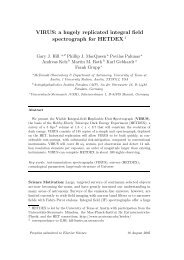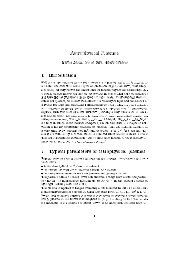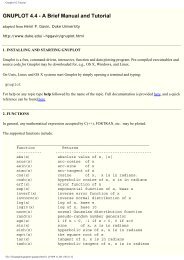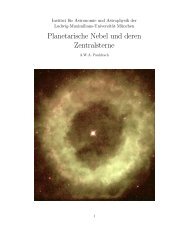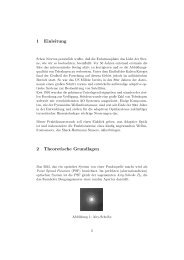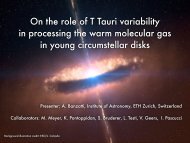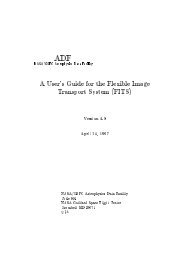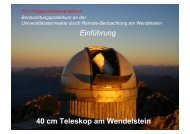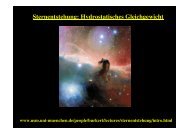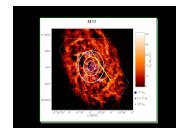Frank Grupp
Frank Grupp
Frank Grupp
Create successful ePaper yourself
Turn your PDF publications into a flip-book with our unique Google optimized e-Paper software.
**FULL TITLE**ASP Conference Series, Vol. **VOLUME**, **YEAR OF PUBLICATION****NAMES OF EDITORS**How accurately can we determine stellar parameters.The case of T eff in cool stars.<strong>Frank</strong> <strong>Grupp</strong>,University Observatory Munich, Scheinerstasse 1, 81679 Müchen,GermanyLyudmila I. Mashonkina,Institute of Astronomy, Russian Academy of Science, Pyatnitskaya 48,119017 Moscow, RussiaAbstract. The determination of stellar effective temperature is one of themost crucial items, when turning to investigate stellar evolution and elementabundances. We address the question of how accurately this parameter can bedetermined from the view of model insecurities.We conclude, that it is not possible to assign a single value of model dependenterror to each method of T eff determination. It is nevertheless obvious, thaterror bars smaller than 75 K are unlikely.1. IntroductionAccurate stellar parameters are a fundamental ingredient to various importantanalysis in astronomy. The accuracy of stellar age determination through thecomparison with modeled evolutionary tracks as well as the determination ofthe abundance of the various elements prominent in stars crucially depends onthe input set of stellar parameters.This paper addresses the errors in the determination of effective temperaturesas one of the most important stellar parameters.As shown by Gehren et al. (2004) for a mildly metal poor turnoff star,an insecurity of ±100 K in effective temperature leads to an insecurity in age of±1.5 Gyrs. For element abundance measurements of main sequence stars, typicaluncertainties corresponding to an error of ±100 K in effective temperature arebetween ±0.02 and ±0.15 Dex depending on T eff and the element investigated(see e.g. Shen et al (2005)).The process of stellar parameter determination is hereby similar for all parametersand all methods available to determine these parameters. Normally onestarts with a first guess set of stellar parameters such as effective temperature(T eff ), surface gravity (log(g)), metallicity ([M/H]), micro turbulence parameter(ξ micro ). In the next step the corresponding model atmosphere is calculated.Based on this atmosphere the overall flux distribution is determined and integratedin order to obtain colors, or single lines are synthesized to make use oftheir dependency on the input parameters. After a comparison of these theoreticallyobtained properties to the measurement a new set of stellar parameters isfixed and this process is iterated to a reasonable level of convergence.1
2 How accurately can we determine stellar parameters.For many users the steps of model atmosphere calculation and determinationof the theoretical quantities such as colors, equivalent widths or line profilesmight be hidden in the use of tabulated data. Nevertheless the described procedureis intrinsically tied to the tabulated data.The model atmospheres used in the process of stellar parameter determinationcan therefore be called the backbone of the procedure. Any parameterdetermination can not be more trustworthy and accurate than the stellar atmosphericmodel it is based upon. This holds true for the Infrared Flux Method(IRFM) for stellar effective temperature measurement, that is sometimes said tobe model independent, but, as shown by Megessier (1994) and <strong>Grupp</strong> (2004b),is not.2. Sources of insecuritiesIn this paper we will concentrate on the influences of the insecurities in modelingthe stellar atmosphere and in calculating stellar line profiles. We will completelyignore insecurities that come into play by observation.All values given for errors belong to our standard solar model.2.1. Model atmospheresWe are using the model atmosphere codes MAFAGS-ODF and MAFAGS-OSdescribed by <strong>Grupp</strong> (2004a). This code is similar to the more commonly usedcodes ATLAS (Kurucz (1979)) and MARCS (Edvardsson et al. (1993)).The basic assumptions of our model are: 1D hydrostatic plane parallellayers, no time dependent processes, local thermal equilibrium (LTE), no chromospherenor corona and flux conservation throughout the atmosphere.Opacity data In stellar atmospheric models we can distinguish between twotypes of opacity sources. The first is related to bound-bound processes, the socalled line opacity. The second is related to bound-free and free-free processesand can be summarized under the keyword continuous opacity.There are essentially two methods of treating line opacity in stellar atmospherecodes. One uses pre-calculated tabulated opacity data, so called opacitydistribution functions (ODF). These ODFs are tabulated on a grid of temperature,gas and electron pressure and are available for a small number of pre-givenelement mixtures. (For details see Kurucz (1979).) A different approach, thattreats ”all” bound-bound transitions individually, and allows for a free choice inthe mixture of species is the opacity sampling (OS) method. As our code existsas a ODF and as a OS version, the latter making use of a database of morethan 20 million lines of the first three ionisation stages, we are able to comparebetween ODF and OS.There are two major sources of continuous opacities: Free-free transitionsand bound-free. While the photon scattering processes are quantum mechanicallywell understood, ionization was treated in simple hydrogenic approximationsuntil recently, when detailed calculations of bound-free cross sectionsbecame available. Figure 1,(left) shows the difference between simple hydrogenicapproximation and the detailed calculations of Bautista (1997) for fourFe I ionization energy levels.
F. <strong>Grupp</strong> & L.I. Mashonkina 3Figure 1. Left: Comparison of simple hydrogenic (full black line) and detailedcalculation for 4 different energy levels of Fe I. Right: Comparison betweenMAFAGS-ODF and MAFAGS-OS model flux for the standard solarmodel.In the right part of Fig. 1 the comparison of the MAFAGS-ODF model withhydrogenic approximations and the MAFAGS-OS model with more detailed dataand individual treatment of the line opacity is shown. It becomes clear, thatcolor integrals are affected by the change in model. As the flux in the ultravioletregion is decreased, revealing what is called the missing UV-opacity problem fluxis redistributed to the red. This affects the infrared flux method temperaturedetermination.For the solar model, the U-B/B-V color temperature changes by 170/45 K.The IRFM temperature is affected by 60 K and the change in temperature structureleads to a change in the temperature determined by Balmer line profiles of50 K.Treatment of convection Convection is a crucial issue in the treatment of stellaratmospheres. For stars with T eff < 10000 K a large fraction of energy in thedeeper layers of the atmosphere is transported by convective movement.As we are only considering 1D hydrostatic atmospheric models we have thechoice between a number of models to treat convection. There are the mostsimple models such as the one by Boehm-Vitense (1981) that allows for onlyone ”type of bubble” and the more complex theories of Canuto & Mazzitelli(1991) that allows for a whole spectrum of eddies.Both theories allow for a free parameter, that describes the efficiency of convection.This α-parameter of convection can be determined using the Balmerseries (see Fuhrmann, Axer and Gehren (1993) and Castelli, Gratton & Kurucz(1997)). However this determination of α can not be done better than ±0.15.Together with the insecure choice of the model this results in an error of approximately10 K for IRFM and U-B/B-V colors and 30 K for the Balmer linetemperatures.Solar element mixture As another source of uncertainty we can identify theelement mixture of the sun. In several recent analysis the abundance of the CNO
4 How accurately can we determine stellar parameters.elements was ”changed” (see several articles in these proceedings). Furthermore,the solar iron abundance is insecure by at least 0.03 Dex. These insecurities leadto possible errors in T eff of 15 K for IRFM, 30/20 K for U-B and B-V colorindices and 15 K for Balmer line temperatures.2.2. Line formationBalmer lines are a well tested method of determining stellar effective temperatures(see e.g. Fuhrmann, Axer and Gehren (1993)). This method comprisestwo extra sources of error.First there are concurrent descriptions of resonance broadening. Figure 2 (left)shows the difference between Ali & Griem (1965) and the more recent work ofBarklem, Piskunov & O’Mara (2000). Second, hydrogen shows departures fromFigure 2. Left: Comarison of Ali & Griem (1965) and Barklem, Piskunov& O’Mara (2000) profiles for the solar H α line. Right: LTE versus Non-LTEH α line of the metal poor star HD19445.AG_vs_BPO_det1.001.00HD 194450.950.90flux0.900.800.850.700.806552 6554 6556 6558 6560 6562λ [Å]H=0.1 (6060 K) and LTE (6010 K)6555 6560 6565 6570local thermal equilibrium in metal poor stars. Figure 2(right) shows calculationsfor the metal poor star HD19445 in LTE and Non-LTE. Neither of the profilesshows a perfect fit, but difference it the determined effective temperature of≈ 50 K become obvious. This effect is minor in solar metallicity stars of thesame temperature range.Together with the stated insecurity in the choice of the resonance broadeningtheory, we need to add an additional error of ≈ 60 K to the Balmer line temperaturevalues due to line formation insecurities.3. Error budget and conclusionsSummarizing the various sources of errors in tab. 1 it turns out to be impossibleto simply sum up the errors. This is neither possible for simple sums nor for doinga quadratic sum, that would assume some Gaussian shape distribution in eachsource of the errors. This might become most obvious in case of the choice of the”proper” convection and resonance broadening theory. These bimodal choices
F. <strong>Grupp</strong> & L.I. Mashonkina 5Table 1. Error budget for T eff of a solar type star. The error source named”computation” is associated with a finite precision of convergence in the modelatmosphere calculation process.IRFM U-B B-V BalmerComputation 10 10 10 10ODF→OS 60 170 55 501D convection 10 10 5 30CNO abundance 15 40 20 15Fe abundance 30 30 25 25Balmer line method 60Quadratic sum 70 180 65 90Total sum 125 260 115 190are clearly non-Gaussian. Instead of summing up the single errors, we wouldrather suggest to look at tab. 1 in the sense of an error budget. It depends onthe science case and the scientist what part of this budget he spends.In a more general view it becomes obvious, that error bars assigned to stellareffective temperatures can hardly ever be smaller than 75 K.Giving an outlook on how we can improve on this situation and get towarda better determined effective temperature we would suggest the following tests:As Balmer lines probe a significant fraction of the stellar atmosphere. Theconsistency between the first 4 series members gives a great test to the models.VLT-Interferometer measurements of nearby main sequence stars could provideus with more stars (other than the Sun) with ”known” stellar parametersto test our methods and procedures.Acknowledgments. In connection to our work special thanks go to ThomasGehren, Zhao Gang, Norbert Przybilla and Shen Zhixia for many helpful discussions.Part of this work was financed by Deutsche Forschungsgemeinschaftunder grant GE-490/31-1.ReferencesAli, A. W. and Griem, H. R. 1965, Physical Review, 140, 1044Barklem, P. S. and Piskunov, N. and O’Mara, B. J. 2000, A&A, 363, 1091Bautista, M. A. 1997, A&AS, 122, 167Boehm-Vitense, E. 1981, ARA&A, 19 295Canuto, V. M. and Mazzitelli, I. 1991, ApJ, 370, 295Castelli, F. and Gratton, R. G. and Kurucz, R. L. 1997, A&A, 318, 841Edvardsson, B. & Andersen, J. & Gustafsson, B. & Lambert, D. L. & Nissen, P. E. &Tomkin, J. 1993, A&A, 275, 101Fuhrmann, K. and Axer, M. and Gehren, T. 1993, A&A, 271, 451Gehren, T. & Liang, Y. C. & Shi, J. R. & Zhang, H. W. & Zhao, G. 2004, A&A, 413,1045<strong>Grupp</strong>, F. 2004a, A&A, 420, 289<strong>Grupp</strong>, F. 2004b, A&A, 426, 309Kurucz, R. L. 1979, ApJS, 40, 1Megessier, C. 1994, A&A, 289, 202Shen, Z.-X. & Jones, B. & Lin, D. N. C. & Liu, X.-W. & Li, S.-L. 2005, ApJ, 635, 608





